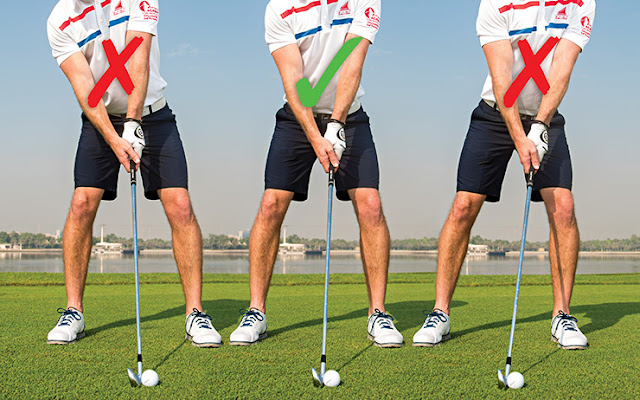Welcome to the world of golf—a sport that combines precision, strategy, and the serene greens of the course. As a beginner stepping onto the fairway for the first time, mastering foundational golf techniques is key to setting a strong foothold in this rewarding game. In this comprehensive guide, we’ll explore crucial golf techniques tailored specifically for beginners, helping you lay the groundwork for a fulfilling golfing journey. From grip to swing mechanics and navigating the course, let’s tee off into the realm of essential golf skills that every novice should embrace.
Perfecting the Grip: Foundation of a Solid Swing

Perfecting the grip is paramount to establishing a robust foundation for a potent golf swing — a crucial connection analogous to the handshake between the player and the club. To comprehend the significance of this fundamental aspect, let’s delve into the intricacies.
Explaining Proper Grip Techniques and Variations
The grip is an intricate balance between control and comfort, with several common variations catering to diverse preferences. The overlapping grip involves the little finger of the trailing hand resting on or between the index and middle fingers of the lead hand. In the interlocking grip, the little finger of the trailing hand securely interlocks with the index finger of the lead hand.
The ten-finger grip, akin to the baseball grip, employs all ten fingers on the club, providing a robust hold but potentially sacrificing some control. Regardless of the chosen style, critical elements such as proper placement in the fingers, balanced pressure, and precise alignment with the forearms contribute to maximizing control and feel.
Emphasizing the Role of Grip in Controlling the Club
The grip serves as the essential link connecting the player’s body with the clubhead, exerting a profound influence on key aspects of the swing. Effective control of the clubface angle at impact is pivotal, ensuring avoidance of slices, hooks, or suboptimal contact. Consistency in grip forms the bedrock for a dependable and replicable swing, while the grip’s impact on power transmission through the club significantly contributes to both distance and accuracy.
Noteworthy is the fact that, while fundamental principles exist, golf professionals often customize their grips to align with their unique playing styles and physical attributes. Mastering the art of the grip requires dedicated practice and patience, with regular checks and refinements ensuring a steadfast foundation for a reliable and effective golf swing.
Stance and Posture: Setting Up for Success

Perfecting your stance and posture in golf is fundamental to achieving a successful swing. Here, we explore key elements that set the stage for a solid and effective performance.
Establishing the Correct Golf Stance for Beginners
For beginners, mastering the right golf stance is paramount. Start with a shoulder-width stance, turn your toes slightly outward, and position the ball appropriately for different clubs. Maintain a straight back, a slight knee flex, and distribute your weight evenly. Align your clubhead and shoulders correctly to establish a foundation that promotes balance and control.
Balancing Weight Distribution and Achieving Posture Precision
Achieving the right balance and posture precision is critical for a successful swing. Ensure even weight distribution on both feet, grounding yourself for stability. Maintain a straight back, engage your core, and keep a relaxed grip on the club. Incorporate a slight knee flex to enhance stability and absorb movement during the swing. These elements collectively contribute to a well-balanced and precisely postured setup, laying the groundwork for a consistent and effective golf swing.
Also, Read More: What Does A King Cobra Eat?
Swing Mechanics: Backswing and Downswing Fundamentals

Understanding the mechanics of the golf swing is pivotal for achieving consistency and power. In this section, we explore the fundamental elements of both the backswing and downswing, providing insights for golfers at all skill levels.
Breakdown of the Swing Components for Beginners
For beginners, a comprehensive understanding of the golf swing components is essential. Break down the swing into its key elements, including grip, stance, posture, and weight distribution. Emphasize the importance of a smooth transition between the backswing and downswing. This foundational knowledge sets the stage for developing a well-rounded and effective swing.
Tips for Executing a Controlled and Efficient Backswing
Executing a controlled and efficient backswing is crucial in golf for setting up a powerful and accurate shot.
Here are some tips for achieving a controlled and efficient Backswing:
Maintain a Relaxed Grip
Start with a grip that is firm enough to control the club but relaxed enough to allow for fluid movement. Tension in your grip can hinder a smooth backswing.
Proper Stance and Posture
Ensure a balanced and athletic stance with your feet shoulder-width apart. Maintain a slight knee flex and tilt forward from your hips. A good posture sets the foundation for a controlled backswing.
One-Piece Takeaway
Initiate the backswing by moving the club, hands, and body away together in one coordinated motion. This promotes a smoother and more connected swing.
Turn the Hips
Rotate your hips and shoulders to create a coiling effect. This not only adds power to your swing but also helps maintain control. Avoid swaying to the side excessively.
Keep the Club on Plane
Maintain the correct swing plane by keeping the clubhead on the desired path. The club should move along a natural arc, with the shaft parallel to the target line during the backswing.
Wrist Hinge
Allow a natural hinge in your wrists as you swing back. This helps to store energy and creates a more powerful downswing.
Full Shoulder Turn
Maximize your shoulder turn to create torque and generate power. A complete turn also helps in maintaining control and balance throughout the swing.
Weight Shift
Shift your weight to the right (for right-handed golfers) as you turn back, loading it onto your back foot. This sets the stage for an effective weight transfer during the downswing.
Maintain Tempo
Focus on a smooth and controlled tempo. Avoid rushing the backswing, as it can lead to loss of control. Consistency in tempo is key for a repeatable swing.
Practice Rhythm
Develop a rhythmic motion by practicing with a metronome or counting in your head. This can help ingrain a consistent and controlled backswing.
Eyes on the Ball
Keep your eye on the golf ball throughout the backswing. This ensures proper focus and helps maintain alignment.
Use Video Analysis
Record your swing and review it to identify any areas where you may be losing control or efficiency in your backswing. This visual feedback can be invaluable for improvement.
Transitioning into a Smooth and Powerful Downswing
Transitioning from backswing to downswing effectively involves these key points:
- Lower Body Initiation: Start the downswing by shifting weight and rotating your hips toward the target.
- Maintain Lag: Keep the wrist angle for a late release, generating more clubhead speed.
- Lead with Hips: Let the hips lead the downswing, followed by the torso and shoulders for a powerful sequence.
- Relaxed Grip: Avoid gripping too tightly to maintain control and a natural release.
- Consistent Posture: Keep your spine angle steady for consistent ball contact.
- Unwinding Motion: Focus on smoothly unwinding your body for controlled power.
- Square Clubface: Aim for a square clubface at impact for accuracy.
- Follow Through: Allow a full follow-through for balance and energy transfer.
- Rhythm and Tempo: Practice with consistent rhythm and tempo for a smooth downswing.
- Engage Legs: Use your legs for added power by pushing off the ground.
- Practice Patience: Progress takes time; keep practicing each aspect gradually.
Short Game Mastery: Putting and Chipping Techniques

Mastering the short game in golf is as crucial as honing the long game. Let’s explore the essential techniques for precision in both putting and chipping, vital skills for lowering scores and improving overall performance.
Essential Techniques for Improving Putting Accuracy
Putting accuracy is the bedrock of a strong short game. Beginners should focus on:
- Alignment: Ensure proper alignment of the putter face and body towards the target.
- Stroke Control: Develop a consistent pendulum-like stroke, maintaining a smooth rhythm.
- Distance Control: Practice distance control by mastering the length of backswing and follow-through.
- Reading Greens: Learn to read slopes and breaks to judge the ideal putting line.
Through consistent practice and attention to these key aspects, golfers can significantly improve their putting accuracy, leading to lower scores on the green.
Chipping Fundamentals for Precise Approach Shots
Chipping is crucial for precision approach shots close to the green. Beginners should focus on:
- Club Selection: Choose the right club based on the distance and desired trajectory.
- Ball Position: Position the ball slightly back in the stance for crisp contact and control.
- Body Alignment: Align your body towards the target with an open stance for chip shots.
- Short Swing: Develop a short, controlled swing with minimal wrist movement.
Mastering these fundamentals empowers golfers to execute precise chip shots, improving their ability to get the ball close to the hole from varying distances around the green. Regular practice and attention to these techniques will significantly enhance short game proficiency, leading to lower scores and increased confidence on the course.
Also, Read More: What Is Technology?
Navigating the Course: Strategic Play and Etiquette

Effectively navigating a golf course involves more than just swinging a club. This section explores the strategic aspects of play, including understanding the course layout and terminology, making strategic shot selections, and adhering to essential golf etiquette for a seamless round.
Understanding Golf Course Layout and Terminology
For golfers to navigate the course successfully, a comprehensive understanding of the layout and terminology is crucial. Topics to focus on include:
- Hole Structure: Learn about tee boxes, fairways, bunkers, and greens on each hole.
- Course Features: Understand water hazards, out-of-bounds areas, and other notable landmarks.
- Yardage Markers: Familiarize yourself with markers for accurate distance assessment.
- Par and Handicap: Grasp the significance of par for each hole and the course’s handicap system.
This knowledge empowers golfers to make informed decisions and navigate the course strategically.
Strategic Shot Selection Based on Hole Design
Strategic shot selection is a key element of successful golf play. Considerations for effective decision-making include:
- Assessing Risks: Evaluate potential hazards and choose shots that minimize risk.
- Leveraging Strengths: Play to your strengths and choose shots that align with your skill set.
- Understanding Hole Design: Analyze the design of each hole to identify optimal landing areas and approach shots.
- Course Management: Develop a strategic plan for the entire round, considering the strengths and challenges of your game.
Strategic shot selection enhances performance and contributes to a more enjoyable round.
Emphasizing Golf Etiquette for a Smooth Round
Golf etiquette is an integral part of the game, fostering respect and consideration for fellow players. Key etiquette points include:
- Pace of Play: Keep up with the group ahead to maintain a steady pace.
- Repairing Divots and Ball Marks: Ensure the course is left in good condition by repairing divots and ball marks.
- Quiet and Stillness: Maintain quiet and stillness while others are playing.
- Respecting Others’ Turns: Adhere to proper order on the course and be mindful of others’ shots.
By prioritizing golf etiquette, players contribute to a positive and enjoyable atmosphere on the course for everyone involved.
Effective Practice Tips for Skill Refinement

Refining skills in golf demands more than just playing rounds. This section delves into the significance of consistent practice, drills, and effective routines tailored to enhance performance and skill development.
Importance of Consistent Practice and Drills
Consistent practice forms the bedrock of skill improvement in golf. Highlight the importance of:
- Repetition
- Focused Drills
- Varied Practice
- Mindful Practice
Consistency in practice, coupled with purposeful drills, accelerates skill development and overall improvement.
Incorporating Effective Practice Routines for Improvement
Crafting effective practice routines tailored to individual needs is pivotal for progress. Encourage golfers to:
- Set Goals
- Warm-Up
- Skill-Specific Focus
- Feedback and Adjustment
By incorporating structured and focused practice routines, golfers can systematically refine their skills, leading to consistent improvement on the course.
Troubleshooting Common Mistakes: Refinement for Progress
Here’s an example of a table outlining common mistakes in golf swings, putting, and chipping, along with their respective refinements for progress:
| Area | Common Mistakes | Refinement for Progress |
| Swing Errors | Over-swinging | Focus on a smoother, controlled swing with proper tempo |
| Poor Alignment | Check alignment of feet, hips, and shoulders | |
| Gripping Too Tightly | Maintain a relaxed grip for better fluidity | |
| Putting Challenges | Inconsistent Stroke | Practice pendulum-like motion for a consistent stroke |
| Deceleration | Ensure a smooth acceleration through the ball | |
| Misreading Greens | Study green slopes and breaks for better reads | |
| Chipping Issues | Mishitting | Focus on striking the ball with a descending blow |
| Improper Club Choice | Choose the appropriate club for the shot at hand | |
| Lack of Follow-Through | Complete the chip with a consistent follow-through |
This table structure helps organize the areas of concern, the specific mistakes within each area, and suggestions for refinement. It’s a useful way to visually outline each aspect and its associated actions for improvement.
Conclusion
Embrace patience and persistence in your golfing odyssey. Skill development takes time; it’s a journey of gradual progress. Each swing and practice session contributes to your growth. Equally important is finding joy in the process. Celebrate small triumphs, relish the challenges, and savor the camaraderie. Golf isn’t just a sport; it’s a pathway to personal growth and enjoyment. Every golfer, beginner or expert, undergoes a continual journey of improvement. Embrace this journey, relish each moment on the course, and treasure the experiences that golf unfolds.
If you Want to Buy any Golf Product, Please Visit our Site
Frequently Asked Questions (FAQs)
Q: How many Balls Should I Hit at the Range?
Ans: There’s no one-size-fits-all answer. Aim for 50-100 balls at the range, but adjust based on your goals and fatigue levels. Quality practice is more important than quantity.
Q: How many Hours a Week should I Practice Golf?
Ans: Aim for 5-7 hours of quality golf practice per week, focusing on different aspects of the game. Adjust based on your goals and progress, and allow for proper rest.
Q: How do I Find the Perfect Golf Grip?
Ans: Experiment with grip variations to find what feels comfortable and natural. Seek guidance from a golf professional to ensure proper fundamentals and make adjustments based on your swing tendencies.
Q: How do you Hit a Driver for Beginners?
Ans: Start with a shoulder-width stance, tee the ball high, position it off your lead heel, and tilt your spine slightly away from the target. Keep a light grip, focus on a smooth tempo, and aim to hit the ball with an ascending strike. Practice with controlled swings to build consistency. Consider taking lessons for personalized guidance.
Q: How can I Practice My Full Golf Swing at Home?
Ans: Practice your full golf swing at home by using a mirror to check your setup and alignment. Focus on your grip, posture, and takeaway. Use a practice mat and a net for hitting foam or plastic balls. Work on your weight transfer, rotation, and follow-through. Video yourself for self-analysis or consider virtual lessons.



